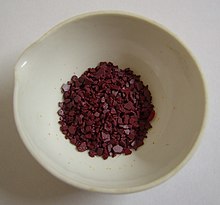Sarett oxidation
The Sarett oxidation is a name reaction in organic chemistry . These were discovered by the American chemist Lewis Hastings Sarett (1917–1999) in 1953. The reaction is used to synthesize aldehydes or ketones .
Overview reaction

During this oxidation , a primary alcohol (R 2 = H) is oxidized with chromium trioxide to an aldehyde . The oxidation of a secondary alcohol (R 1 , R 2 = organyl group , e.g. alkyl group ) produces a ketone analogously.
Reaction mechanism
A possible reaction mechanism will be explained using the example of the oxidation of a primary (R 2 = H) or secondary (R 2 = organyl group ) alcohol 1 :
The hydroxyl group of alcohol 1 attacks the chromium, which creates the oxonium ion 2 . By shifting a proton , the charge in 2 can be balanced and the chromium compound 3 is created . By splitting off a proton and a chromium ion with the aid of pyridine (Py), the aldehyde (R 2 = H) or the ketone (R 1 , R 2 = organyl group, e.g. alkyl or aryl group) 4 can be obtained.
Disadvantages of the Sarett oxidation
Chromium (VI) oxide or chromium trioxide is a dangerous substance that has a carcinogenic effect - can cause genetic defects - and burns the eyes or skin on contact. Repeated exposure can cause organ damage. It is fire-promoting, mixed with combustible substances it is highly flammable and easily soluble in water. In addition, it has a strongly acidic effect in water through the formation of chromic acid and in solutions it can be absorbed through the skin. Therefore, the alternative use of other, less dangerous oxidizing agents should be checked beforehand, e.g. B. of oxygen difluoride , potassium permanganate or hydrogen peroxide .
See also
Individual evidence
- ↑ a b Z. Wang (Ed.): Comprehensive Organic Name Reactions and Reagents, 3 Volume Set . John Wiley & Sons, Hoboken, New Jersey 2009, ISBN 978-0-471-70450-8 , p. 2476.
- ↑ Poos, GI; Arth, GE; Beyler, RE; Sarett, LH: Approaches to the Total Synthesis of Adrenal Steroids. 1V. 4b-Methyl-7-ethylenedioxy-1,2,3,4,4aα, 4b, 5,6,7,8,10,10a β-dodecahydrophenanthrene-4 β-ol-1-ones and Related Tricyclic Derivatives . In: Journal of the American Chemical Society . tape 75 , no. 2 , 1978, p. 422-429 , doi : 10.1021 / ja01098a049 .
- ↑ M. Windholz (Ed.): The Merck Index, Ninth Edition . Merck & Co., 1976, ISBN 978-0-911910-26-1 , p. ON-79.
- ↑ Z. Wang (Ed.): Comprehensive Organic Name Reactions and Reagents, 3 Volume Set . John Wiley & Sons, Hoboken, New Jersey 2009, ISBN 978-0-471-70450-8 , p. 2477.
- ↑ Entry on chromium (VI) oxide in the GESTIS substance database of the IFA , accessed on November 9, 2015(JavaScript required) .

